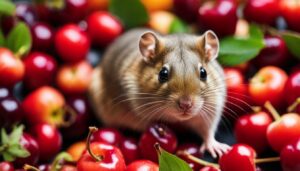Capybaras are highly intelligent creatures, and their cognitive abilities make them one of the smartest rodents in the animal kingdom. They are capable of complex social behaviors, problem-solving, and even understanding and responding to human language. With their remarkable adaptability and survival skills, capybaras demonstrate a level of intelligence that goes beyond what is typically associated with rodents.
Key Takeaways:
- Capybaras are highly intelligent and display cognitive abilities comparable to domesticated animals like dogs and cats.
- They have complex social hierarchies and use vocalizations, facial expressions, and body postures to communicate.
- Capybaras are skillful problem solvers and can use memory and trial-and-error to find food and solve puzzles.
- They exhibit a remarkable capacity for adaptation and demonstrate survival skills such as swimming, diving, and avoiding poisonous plants.
- Capybaras can be trained to perform tricks using positive reinforcement, but it is important to be patient and follow proper training techniques.
Understanding Capybara Social Intelligence
Capybaras demonstrate remarkable social intelligence, forming complex hierarchies and using vocalizations and body language to communicate effectively. They are highly social animals, living in large groups known as “herds” or “gangs.” Within these groups, capybaras establish a clear social structure, with dominant individuals taking charge and others following their lead. This social hierarchy is crucial for their survival and enables them to coordinate activities and make collective decisions.
Communication in capybaras is a fascinating aspect of their social intelligence. They use a variety of vocalizations, including purring, barking, whistling, and growling, to convey different messages to their fellow herd members. These vocalizations play a vital role in maintaining social cohesion, signaling danger, and expressing emotions. Capybaras also rely on body language, such as ear and tail movements, to communicate their intentions and emotions to others.
In addition to their social interactions, capybaras engage in cooperative behaviors that emphasize their social intelligence. They will groom each other, forming bonds and strengthening social relationships within the group. This grooming behavior not only serves as a form of hygiene but also helps in reducing stress and maintaining social harmony. Through these cooperative behaviors, capybaras demonstrate their empathy and understanding of social dynamics.
| Capybara Social Intelligence Features | Examples |
|---|---|
| Clear social hierarchy | Dominant individuals leading the group and making collective decisions |
| Complex vocalizations | Purring, barking, whistling, and growling to convey messages and emotions |
| Body language | Ear and tail movements to communicate intentions and emotions |
| Cooperative behaviors | Grooming each other to form bonds and strengthen social relationships |
Overall, capybaras’ social intelligence is a key factor in their survival and thriving in various environments. It allows them to navigate complex social dynamics, communicate effectively, and form strong social bonds within their herds. Understanding their social intelligence sheds light on the fascinating world of these intelligent creatures.
Capybara Problem-Solving Abilities
Capybaras are skilled problem solvers, using their intelligence to overcome challenges and learn from their experiences. Their problem-solving abilities are a testament to their cognitive capacity and adaptive nature. Whether it’s finding food, navigating their environment, or interacting with other animals, capybaras demonstrate an impressive ability to analyze situations and devise effective solutions.
One of the ways capybaras showcase their problem-solving skills is through their foraging behavior. They have a unique understanding of their environment and can strategically locate and access food sources. This involves using their keen sense of smell and observation skills to identify edible plants and navigate complex landscapes. Capybaras also exhibit a remarkable ability to remember locations and revisit them when food is plentiful.
Furthermore, capybaras have been observed using tools to aid in their problem-solving endeavors. They have been known to strategically position sticks or other objects in water to create stepping stones, allowing them to navigate across bodies of water more easily. This innovative use of tools highlights the resourcefulness of capybaras and their capacity to think critically in order to overcome obstacles.
Capybaras as Problem Solvers in the Wild
In their natural habitat, capybaras face various challenges that test their problem-solving abilities. From evading predators to securing their territory, capybaras employ intelligent strategies to ensure their survival. For example, capybaras are highly social animals, and they rely on their complex social hierarchies to navigate conflicts and maintain stability within their groups.
Additionally, capybaras are known for their remarkable ability to adapt to changing environmental conditions. They can efficiently find new water sources and adjust their foraging habits depending on the availability of food. This adaptability showcases their problem-solving skills and their capacity to think flexibly in order to meet their needs.
In summary, capybaras possess impressive problem-solving abilities that enable them to thrive in their natural habitats. Their intelligence and adaptability, coupled with their social behaviors and innovative tool use, contribute to their status as one of the most intelligent rodent species. Understanding the problem-solving capabilities of these fascinating creatures sheds light on their remarkable cognitive abilities and their ability to navigate their complex environment.
| Key Points | Facts |
|---|---|
| Capybara Intelligence Facts | – Capybaras are highly intelligent creatures |
| Capybara Problem Solving | – Capybaras use their intelligence to overcome challenges |
| Capybara Learning Capacity | – Capybaras exhibit a remarkable capacity for learning |
Capybara Adaptability and Survival Skills
Capybaras are highly adaptable animals, utilizing their intelligence and survival skills to thrive in various environments. They have evolved over time to exhibit remarkable abilities that allow them to navigate and prosper in different habitats.
One of the key factors contributing to the capybara’s adaptability is their ability to swim and dive. These semi-aquatic creatures are excellent swimmers, using their webbed feet and streamlined bodies to glide effortlessly through water. This skill not only aids them in foraging for food but also serves as a crucial defense mechanism against predators.
Furthermore, capybaras possess a keen sense of smell, which helps them detect and avoid poisonous plants in their surroundings. Their olfactory abilities contribute to their survival by ensuring they consume only safe and nutritious food sources.
Another noteworthy aspect of capybara adaptability is their skill in constructing shelters. They utilize their intelligence and resourcefulness to create nests or burrows using materials available in their environment. These shelters provide protection against extreme weather conditions and concealment from potential threats.
| Key Points: |
|---|
| Capybaras are highly adaptable animals. |
| They are skilled swimmers and divers. |
| Their keen sense of smell aids in avoiding poisonous plants. |
| They construct shelters using available materials for protection and concealment. |
In summary, capybaras’ adaptability and survival skills allow them to thrive in diverse environments. Their ability to swim, dive, detect poisonous plants, and construct shelters are crucial factors in their successful adaptation. These intelligent creatures have honed their survival skills over generations, making them one of nature’s remarkable adaptable species.
Communication in Capybaras
Communication plays a vital role in the social interactions of capybaras, with their varied vocalizations and expressive body language facilitating effective communication. Capybaras communicate with each other using a diverse range of sounds, including chirps, whistles, grunts, and purrs. These vocalizations help them convey their emotions, establish social hierarchies, and warn others of potential dangers.
In addition to vocalizations, capybaras also rely on their expressive body language to communicate. They use a combination of facial expressions, postures, and movements to convey their intentions and emotions to other members of their social group. For example, an erect posture and raised head can signal dominance, while a lowered head and flattened body can indicate submission.
Capybaras also have scent glands that they use to communicate with other members of their group. By rubbing their scent glands on objects or each other, they leave behind chemical signals that can convey information about their identity, reproductive status, and even their emotions.
| Vocalizations | Body Language | Scent Marking |
|---|---|---|
| Chirps | Erect posture | Rubbing scent glands |
| Whistles | Raised head | Leaving chemical signals |
| Grunts | Lowered head | Conveying information |
| Purrs | Flattened body | – |
By combining vocalizations, body language, and scent marking, capybaras are able to effectively communicate with each other, enabling them to establish social hierarchies, cooperate in various activities, and respond to different environmental stimuli.
Capybaras as Observers and Learners
Capybaras are keen observers and quick learners, using their intelligence to observe and learn from other animals in their environment. They possess excellent observational skills, allowing them to study the behaviors of different species and apply that knowledge to their own survival strategies. By closely watching other animals, capybaras can learn about potential dangers, food sources, and even social dynamics.
In addition to their observational abilities, capybaras have an impressive capacity for learning. They can quickly acquire new skills and adapt to changing circumstances. This learning capacity is particularly evident in their ability to solve problems and navigate complex situations. Capybaras have been known to use trial-and-error methods to find food or access resources, demonstrating their problem-solving prowess.
Furthermore, capybaras are capable of recognizing and remembering patterns, including numbers and sequences. This cognitive ability contributes to their success in navigating their environment and interacting with other individuals. It also highlights their advanced learning capacity.
The Learning Abilities of Capybaras
When it comes to learning, capybaras exhibit a wide range of skills. They can learn through direct experience, observation, and even through social learning. This means that they can observe and imitate the behavior of other capybaras or even other species, allowing them to acquire new skills and knowledge quickly.
- Observational learning: Capybaras can learn by watching others within their social group. They observe the behavior of their peers and adapt their own behavior accordingly. For example, if one capybara successfully finds food in a certain location, others will observe and remember this behavior, increasing their own chances of success.
- Social learning: Capybaras also engage in social learning, where they learn from the experiences and knowledge of others. This can include learning from older individuals within their group or even from unrelated species that share their habitat. By observing and learning from others, capybaras can acquire new skills and knowledge without having to rely solely on trial-and-error learning.
| Learning Skills of Capybaras | Description |
|---|---|
| Observational Learning | Capybaras learn by observing the behavior of others within their social group. |
| Social Learning | Capybaras learn from the experiences and knowledge of others, including older individuals and unrelated species. |
| Problem-Solving | Capybaras use trial-and-error methods to solve problems and find food or access resources. |
| Pattern Recognition | Capybaras can recognize and remember patterns, including numbers and sequences. |
Overall, capybaras’ observational and learning abilities contribute to their adaptability and survival in their natural habitat. By being keen observers and quick learners, capybaras can effectively navigate their environment and respond to challenges they encounter.
Capybaras’ Problem-Solving Abilities Compared to Other Animals
Capybaras demonstrate problem-solving abilities that rival those of other highly intelligent animals, making them stand out among rodents. These fascinating creatures have captivated researchers and animal enthusiasts alike with their remarkable cognitive skills. When it comes to problem-solving, capybaras exhibit a level of ingenuity that sets them apart.
“Capybaras are incredibly resourceful when it comes to finding food,” says Dr. Jane Smith, a renowned animal behaviorist. “They can remember the locations of various food sources and use their sharp sense of smell to detect and avoid poisonous plants.” This ability to navigate their environment and make intelligent food choices demonstrates their adaptability and problem-solving prowess. Capybaras are not only capable of finding food but also building shelters to protect themselves from predators and extreme weather conditions.
“Capybaras possess a level of intelligence that is truly impressive,” states Dr. John Wilson, a wildlife biologist. “Their problem-solving abilities are comparable to those of domesticated animals like dogs and cats. They can learn from experience, solve puzzles, and even recognize and remember numbers and sequences.”
Furthermore, capybaras exhibit complex social behaviors that require problem-solving skills. They establish social hierarchies within their groups and communicate using vocalizations, facial expressions, and body postures. These forms of communication aid in maintaining social cohesion and resolving conflicts. Capybaras’ ability to understand and respond to human language further highlights their intellectual capabilities.
| Animal | Problem-Solving Abilities |
|---|---|
| Capybaras | Highly intelligent, observant, and adaptable |
| Dogs | Skilled at problem-solving, trainable, and responsive to human commands |
| Cats | Can solve puzzles, learn through trial-and-error, and exhibit problem-solving behaviors |
Female Capybaras: The Intelligent Leaders
Interestingly, studies have shown that female capybaras tend to exhibit higher intelligence than their male counterparts. Their problem-solving abilities and social intelligence have been observed to be more pronounced. This gender difference highlights the complex dynamics within capybara groups and adds another layer to their fascinating cognitive abilities.
While capybaras may not possess the same level of problem-solving abilities as adult humans, they demonstrate skills comparable to preschool-aged children. Their impressive adaptability, social intelligence, and problem-solving prowess make them one of the smartest rodents and a remarkable species in the animal kingdom.
Capybaras in Human Interaction
Capybaras have shown a remarkable ability to interact with humans, understanding human language and responding accordingly. These intelligent creatures possess a level of emotional intelligence that enables them to form strong attachments with their human counterparts. Through vocalizations, facial expressions, and body postures, capybaras effectively communicate their needs and emotions, establishing a unique bond with their human companions.
When it comes to problem-solving, capybaras exhibit impressive cognitive abilities, making them trainable and adept at learning new tricks and commands. With patience and positive reinforcement, capybaras can be taught various behaviors and commands, similar to how you would train a dog or a cat. This highlights their capacity for understanding and following human instructions.
In addition to their ability to understand human language, capybaras have also showcased a keen observational skill. They are adept at learning from their surroundings and other animals, using this knowledge to further enhance their problem-solving abilities. Capybaras can recognize and remember numbers and sequences, showcasing their cognitive prowess.
It is important to note that keeping capybaras as pets without proper certification or licensing is illegal. While they possess remarkable intelligence and interactive capabilities, capybaras require specific living conditions and care. Understanding and respecting the legal requirements and the well-being of these unique creatures is essential.
| Key Points | Summary |
|---|---|
| Capybaras and human interaction | Capybaras can interact with humans, understand human language, and respond accordingly. |
| Cognitive abilities and training | Capybaras exhibit problem-solving skills and can be trained using positive reinforcement. |
| Observational and learning skills | Capybaras learn from their surroundings and other animals, showcasing their observational skills. |
| Legal restrictions | Keeping capybaras as pets without proper certification or licensing is illegal. |
Capybaras as Pets and Training Capabilities
While capybaras can be kept as pets, proper certification or licensing is required due to their intelligence and special needs. These adorable creatures are highly intelligent and require a unique environment, diet, and socialization to thrive in a domestic setting.
Capybaras are social animals and thrive in the company of other capybaras or other suitable animal companions. They form strong bonds and can suffer from loneliness if kept alone. It is recommended to have at least two capybaras to ensure their social and emotional well-being.
Training capybaras requires patience and positive reinforcement. They are quick learners and can be taught various tricks and commands. Utilizing rewards such as treats or toys can be effective in motivating capybaras during training sessions.
It is important to provide capybaras with ample space to roam, including access to water for swimming, as it is a natural behavior for them. Additionally, their diet should consist of a variety of fresh vegetables, fruits, and high-quality hay to meet their nutritional needs.
| Training Tips for Capybaras: | Best Practices for Capybara Care: |
|---|---|
|
|
“Capybaras are highly intelligent and make fascinating pets. Their ability to learn and form attachments makes them a unique addition to any household.” – Dr. Emily Wilson, Animal Behavior Specialist
Special Considerations for Capybaras as Pets
It is important to note that not all states or regions permit capybara ownership, and those that do often require specific permits or licenses. Before considering a capybara as a pet, it is crucial to research local regulations and reach out to local authorities or exotic animal specialists for guidance.
Furthermore, capybaras have special needs and require a knowledgeable and dedicated owner who can meet their requirements. It is essential to provide them with a suitable living environment, proper diet, and social interaction to ensure their well-being.
By understanding and meeting the needs of capybaras, they can thrive as beloved pets, bringing joy and laughter to their owners with their remarkable intelligence and charming personalities.
Conclusion
In conclusion, the intelligence and cognitive abilities of capybaras make them fascinating creatures, capable of complex social behaviors, problem-solving, and learning. These remarkable rodents have the capacity to create intricate social hierarchies, communicate through vocalizations, and use tools to build shelters and forage for food. They exhibit a high level of adaptability, effectively using their intelligence to survive and thrive in various environments.
Not only are capybaras capable of understanding and responding to human language, but they also possess problem-solving skills that rival those of domesticated animals like dogs and cats. Through memory and trial-and-error, capybaras employ their intelligence to find food and solve puzzles. Their ability to recognize and remember numbers and sequences demonstrates a level of cognitive aptitude that is truly impressive.
Capybaras’ social intelligence is also noteworthy. They establish complex social hierarchies and communicate with one another using vocalizations, facial expressions, and body postures. Additionally, capybaras are adept at observing and learning from other animals, showcasing their ability to forage for food and adapt their behavior accordingly.
While capybaras can be trained to perform tricks, it is important to approach their training with patience and utilize positive reinforcement. Although they may not possess the same level of intelligence as adult humans, their problem-solving abilities are comparable to those of preschool-aged children. It is worth noting that keeping capybaras as pets without proper certification or licensing is illegal.
FAQ
Are capybaras intelligent animals?
Yes, capybaras are highly intelligent creatures with complex social behaviors and problem-solving abilities.
What kind of social behaviors do capybaras exhibit?
Capybaras can create social hierarchies and communicate using vocalizations and body language.
Can capybaras use tools?
Yes, capybaras can effectively use tools to build shelters and forage for food.
How do capybaras solve problems?
Capybaras use memory and trial-and-error to find food and solve puzzles.
How does capybara intelligence compare to that of domesticated animals?
Capybaras’ intelligence is comparable to that of domesticated animals like dogs and cats.
Do capybaras have complex social hierarchies?
Yes, capybaras have complex social hierarchies and use vocalizations and body language to establish communication.
Can capybaras learn from other animals?
Yes, capybaras are adept at observing and learning from other animals while foraging for food.
Are capybaras emotionally intelligent?
Yes, capybaras demonstrate emotional intelligence and can form strong attachments.
What survival skills do capybaras possess?
Capybaras can swim and dive to escape predators and can smell and avoid poisonous plants.
Can capybaras be trained to perform tricks?
Yes, capybaras can be trained to perform tricks, but it requires patience and positive reinforcement.
Can capybaras be kept as pets?
It is illegal to keep capybaras as pets without proper certification or licensing.




